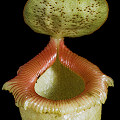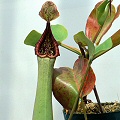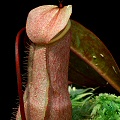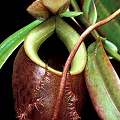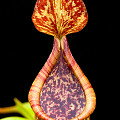| Filipino species | |
|---|---|
| Lowlanders | Highlanders |
|
N. abalata4,6 N. abgracilis1 N. armin4 N. bellii1 N. cid1 N. leyte4,6 N. merrilliana1,2 N. philippinensis1 N. ramos1,6 N. samar4 N. ultra5,6 N. viridis4 |
N. aenigma5 N. alzapan5 N. argentii4 N. attenboroughii4 N. barcelonae5 N. burkei5 N. ceciliae1,6 N. copelandii1,6 N. deaniana1 N. extincta1,6 N. gantungensis4 N. hamiguitanensis1,6 N. justinae1 N. kitanglad1,6 N. leonardoi4 N. mantalingajanensis1 N. micramphora1 N. mira1 N. nebularum1 N. palawanensis4 N. pantaronensis1 N. petiolata1 N. pulchra1 N. robcantleyi1 N. saranganiensis1,6 N. sibuyanensis4 N. sumagaya1 N. tboli1 N. ventricosa5 N. zygon1 |
| Highland-lowland | |
|
N. alata1,4,5,6 N. cornuta1,6 N. graciliflora1,4,5,6 N. mindanaoensis1,6 N. mirabilis3 N. negros4,6 N. peltata1 N. surigaoensis1 N. talaandig1 N. truncata1 |
|
|
1South Philippines. 2Danser (1928) also cites this species as occurring in Sulawesi, but Jebb & Cheek (1997) disagree. 3Also in Borneo, Sumatra, Thailand, Peninsular Malaysia, Sulawesi, Maluku, New Guinea, Australia, Java, Indo-China, China, Hong Kong, Macau, Palau. 4Central Philippines. 5North Philippines. 6Part of the "N. alata group", perhaps conspecific. |
|
Q: Nepenthes: species of the Philippines
A: The Philippines is an autonomous island nation in Southeast Asia, northeast of Borneo.
It is highly fragmented, and consists of more than 7000 separate islands. Very approximately, the Philippines can
be divided into three portions--north, central, and south.
The northern Philippines are dominated by the large island of Luzon, which at about 105,000km2 represents 35% of all
the Philippines land area. Many additional small islands are considered part of the administrative structure of the northern
Philippines (although the political-administrative system is much more complicated than I care to delve into, as you might expect
for such a geographically fragmented country). The southern portion of Luzon, in the Bicol region, is noteworthy for being the
birthplace of Professor Max M. Pallen, noted martial arts expert who happens to be a grandmaster that your FAQ-author had the
honor of training under! But I
digress.
Southern Philippines mostly consists of the single large island Mindanao. At 98,000km2, it comprises another 33% of
the Philippines.
The central Philippines consists of many smaller islands, which are grouped into the Visayas island groups. The major Visayan islands (from
east to west) includes Samar, Leyte, Bohol, Cebu, Negros, Panay, and far off to the west, Palawan.
The Philippines is the only major center of Nepenthes diversity that has not been uniformly treated in
the way that Charles Clarke did with his books on Sumatra, Borneo, and Peninsular Malaysia. This is a real pity since there are
some fabulous species in the country. Indeed, looking at the table on this page you will notice that nearly all the
species in the Philippines are endemic---the only ones that occur elsewhere are N. mirabilis, and
possibly (but probably not) N. merrilliana.
Since there is no uniform treatment of this group of plants, and since there has been an explosion of new species since McPherson (2011),
I am hard pressed to assess how good many of these species are. If there are some doubts about the species, usually from Jan Schlauer's
database, I usually mention them in the thumbnail comments below.
Nepenthes aenigma
This plant is what McPherson (2011) called "sp. Luzon," possibly a synonym
of Nepenthes barcelonae.
Nepenthes alata
A species that is found throughout much of the nation, and that has many variant forms.
The polymorphic nature of this species makes many people scratch their heads in confusion. Many of the other species from this region can look similar
to forms of Nepenthes alata, and this has caused a lot of confusion--or should I say, "alata confusion"? Hah hah hah.
I am quite fond of the intensely
speckled or spotted forms.
Nepenthes argentii
This species grows in extremely exposed conditions on Mt. Guiting-Guiting,
and has tiny pitchers.
Nepenthes armin
Possibly a synonym
of Nepenthes saranganiensis.
Nepenthes attenboroughii
A huge-pitchered species known only from the ultramafic sumit of
Mount Victoria, Palawan.
Nepenthes bellii
A small species, ideal for terraria, native to the Surigao provinces of Mindanao.
Nepenthes burkei
From what I understand, many of the N. burkei in collections are
really specimens of the very similar N. ventricosa.
Nepenthes copelandii
Although I did not think it was separate from N. alata,
Rob Cantley has told me that it probably is, so on his authority I will consider it as such. It is from Mt. Apo, and Mt. Pasian, on
Mindanao.
Nepenthes cornuta
From around 1000 m elevation, I tentatively call it highland-lowland. Anyone with better information?
Nepenthes deaniana
A species found in the Philippines (the type was collected on Mt. Pulgar).
Nepenthes extincta
A species known only from an herbarium specimen, and may be extinct!
Nepenthes gantungensis
A species found on Mt. Gantung, Palawan.
Nepenthes graciliflora
Possibly synonymous with N. alata.
Nepenthes hamiguitanensis
A species found on Mindanao Island.
Nepenthes justinae
Possibly synonymous with N. mindanaoensis.
Nepenthes kitanglad
Possibly synonymous with N. saranganiensis.
Nepenthes leonardoi
A species known only from Palawan.
Nepenthes leyte--Possibly synonymous with N. alata.
Nepenthes mantalingajanensis
Only known from Palawan. This species is described from cultivated
material, which is a bit dubious, but presumably the authors salted the description of cultivated material with opinions
derived from observatins in the wild.
Nepenthes merrilliana
Only known from Surigao del Norte, and Dinagat Island in Mindanao.
Nepenthes mindanaoensis
A N. alata-like plant, that as you might expect, is
from Mindanao.
Nepenthes mira
A species known only from Palawan.
Nepenthes nebularum
Associated with N. truncata and N. robcantleyi; I will leave it to
more expert eyes than mine to sort this out!
Nepenthes negros
Possibly synonymous with N. alata; I cannot find information about it's
altitudinal range, but based upon its affinity with N. alata, I am tentatively calling it highland-lowland.
Nepenthes palawanensis
A species found on Sultan Peak, Palawan.
Nepenthes pantaronensis
Possibly synonymous with N. mindanaoensis.
Nepenthes peltata
From Mt. Hamiguitan Range, Mindanao, with
peltate leaf tips, ovoid pitchers, a basal lid crest, and large nectar glands on the lid.
Nepenthes petiolata
A species known only from Mindanao.
Nepenthes philippinensis
Another N. alata-like plant, this one from
Palawan.
Nepenthes pulchra
Possibly synonymous with N. mindanaoensis.
Nepenthes ramos
This absorbed N. kurata.
Nepenthes robcantleyi
Formerly known as N. 'Queen of Hearts,' Cheek argues
that this is not a hybrid, but rather a true species from an unspecified highland location in Mindanao, while
Mansell & Suarez (2017) consider this to be a hybrid between N. truncata
and N. nebularum.
Nepenthes samar
Possibly synonymous with N. merrilliana.
Nepenthes saranganiensis
A species known only from Sarangani Province, Mindanao.
Nepenthes sibuyanensis
A glossy plant (much like N. ventricosa in this
regard) that is found only on Sibuyan.
Nepenthes sumagaya
First published as Nepenthes amabilis.
Nepenthes talaandig
Possibly synonymous with N. mindanaoensis.
Nepenthes tboli
Possibly synonymous with N. ramos.
Nepenthes truncata
The rounded or heartshaped leaves are remarkable. Many plants in cultivation
in the USA have very tall, narrow pitchers. However, many other clones are much more squat and fat.
It lives on Mindanao.
Nepenthes ultra
Possibly synonymous with N. alata. The name notes that the plant
grows in utramafic soils, which you have to admit is kind of a let down.
Nepenthes ventricosa
This species has very waxy, glossy pitchers that are red, green, or speckled. My
favorite are so creamy and ghostly pale, they look almost fungal. Known only from Luzon.
Nepenthes viridis
As you might guess from the name, a yellowish-green plant.
Nepenthes zygon
Possibly synonymous with N. ramos. Information on its
altitude is unclear; I am tentatively calling it highland, based upon references to the original seed being collected
from a peak.
Page citations: Cheek, M. 2011, 2014;
Cheek, M. and Jebb, M.H.P. 2013a, 2013b; 2013c, 2013d, 2013e, 2013f, 2013g, 2013h, 2014;
Cheek, M. et al. 2015;
Danser, B.H. 1928; Jebb, M.H.P., and Cheek, M. 1997; Gronemeyer et al. 2011a, 2011b;
Gronemeyer et al. 2014; Gronemeyer et al. 2016;
Kurata, S. 2008; Mansell, G. & Suarez, W. 2016,2017;
McPherson, S. 2009b, 2010; McPherson, S. et al. 2011; Micheler, M., et al. 2013;
Nerz, J., and Wistuba, A. 2007; Rice, B. 2006a; Robinson et al. 2009; Schlauer, J. 2002.
